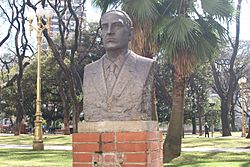Manuel Gálvez facts for kids
Quick facts for kids
Manuel Gálvez
|
|
|---|---|
 |
|
| Born |
Manuel Gálvez
18 July 1882 |
| Died | 14 November 1962 (aged 80) |
| Monuments | Bust in Plaza Vicente Lopez, Buenos Aires |
| Education | Law degree (1904) |
| Alma mater | University of Buenos Aires |
| Occupation | Inspector of schools |
| Known for | Writer |
|
Notable work
|
Nacha Regules (1919), Historia de arrabal (1923), Los caminos de la muerte (1928), El general Quiroga (1932) |
| Style | Romanticism, Costumbrismo |
Manuel Gálvez (born July 18, 1882 – died November 14, 1962) was an important Argentine writer. He wrote many novels, poems, essays, and historical books. He was also a biographer, meaning he wrote about the lives of other people.
Contents
Early Life and Education
Manuel Gálvez came from a well-known family in Entre Ríos Province, Argentina. He went to school with the Jesuits, a religious order known for their education. Later, he studied at the University of Buenos Aires and became a lawyer in 1904.
From 1906 to 1931, Gálvez worked as a schools inspector. This job allowed him to travel and see different parts of Argentina.
During his university years, he helped start a literary magazine. He became very interested in Spanish culture and history. He believed that Argentina should have strong cultural ties with Spain. He also thought the Roman Catholic Church was very important to Argentina's identity.
Manuel Gálvez and Nationalism
Developing Nationalist Ideas
Between 1906 and 1910, Manuel Gálvez often visited Spain. These trips made his belief in "Hispanidad" even stronger. This idea meant having close cultural connections with Spain. He wrote about these ideas in his 1913 book, El Solar de la Raza.
Gálvez became linked to a type of nationalism popular among Argentina's upper classes. Nationalism is a strong feeling of pride in one's country. He even said he was the first true Argentine nationalist. He worried that Argentina's culture was changing too much. He believed this was happening because of new people arriving in the country. He thought these new influences were making Argentina less traditional.
His book El Solar de la Raza was very important for Argentine nationalism. It said that the true spirit of Argentina was found in the countryside. He felt that cities were too influenced by international ideas.
Supporting Juan Manuel de Rosas
Manuel Gálvez was one of the first nationalist writers to admire Juan Manuel de Rosas. Rosas was a powerful leader in Argentina's past. Gálvez saw Rosas as a symbol of true Argentine values. Many other writers later agreed with him.
Gálvez wrote five novels about Rosas's time as a leader. He also helped edit a journal named after Rosas. He was the Vice President of a group called the Instituto de Investigaciones Historicas 'Juan Manuel de Rosas'. This group, started in 1938, studied Argentine history.
Later Political Views
At first, Gálvez did not want big changes to Argentina's government. But in 1925, he started to support Italian fascism. This was a type of government where a strong leader had a lot of power. He thought it was the only way to stop what he saw as weak government. He also believed it could prevent the spread of ideas like communism and stop too much immigration.
Gálvez said he was not against Jewish people. He claimed he was against all immigration, not just Jewish immigration. However, some of his later writings were criticized for how they showed Jewish characters. Even though he supported some ideas of fascism, he always kept his traditional conservative views. When Juan Perón became President in 1946, Gálvez strongly supported his new government.
Manuel Gálvez's Writing Career
Manuel Gálvez was a very productive writer. He wrote in many different styles and genres.
Novels and Plays
Some of his novels include La sombra del convento, El cántico espiritual, and La muerte en las calles. His most famous novels were Nacha Regules (1919) and Historia de arrabal (1923). He won literary prizes for Los caminos de la muerte (1928) and El general Quiroga (1932). He also wrote plays, such as El hombre de los ojos azules (1928).
Gálvez was nominated five times for the Nobel Prize in Literature. However, he never won the award.
Later Works and Poetry
In the 1950s, Gálvez wrote even more books. These included Tiempo de odio y angustia (1951) and Recuerdos de la vida literaria (1961).
His first book of poetry was El enigma interior in 1907. He also wrote for Nostros, a cultural magazine, as an art critic.
Essays and Biographies
As an essayist, he published works like El solar de la raza (1913) and Amigos y maestros de mi juventud (1944). He also wrote biographies about important historical figures. These included Domingo Faustino Sarmiento, Hipólito Yrigoyen, and Gabriel García Moreno.
Personal Life
Manuel Gálvez was married to the writer, Delfina Bunge. He passed away in 1962 in Buenos Aires, Argentina.
See also
 In Spanish: Manuel Gálvez para niños
In Spanish: Manuel Gálvez para niños


